Moderate overlap front: original test
Rating applies to 2005-08 models
Tested vehicle: 2005 Ford Escape XLT 4-door 4wd
The Ford Escape and Mazda Tribute were introduced in the 2001 model year and structurally modified beginning with 2005 models to improve occupant protection in frontal crashes. The Mercury Mariner, introduced in the 2005 model year, also had the structural modifications. The Mazda Tribute skipped the 2007 model year. All three models were modestly restyled for the 2008 model year, and electronic stability control was added as a standard feature.
Note: These ratings and specifications do not apply to the hybrid (gas-electric) versions of the Escape and Mariner.
| Evaluation criteria | Rating |
|---|---|
| Overall evaluation | |
| Structure and safety cage | |
| Driver injury measures | |
| Head/neck | |
| Chest | |
| Leg/foot, left | |
| Leg/foot, right | |
| Driver restraints and dummy kinematics | |

Action shot taken during the frontal offset crash test.
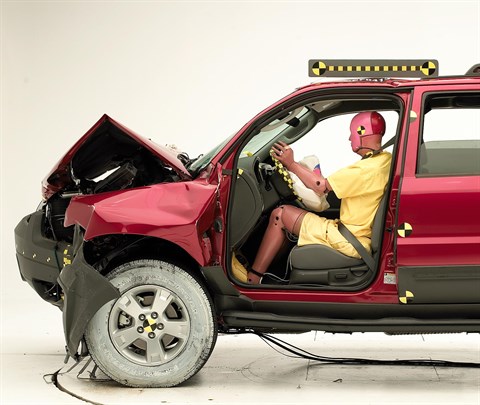
The dummy's position in relation to the steering wheel and instrument panel after the crash test indicates that the driver's survival space was maintained reasonably well.
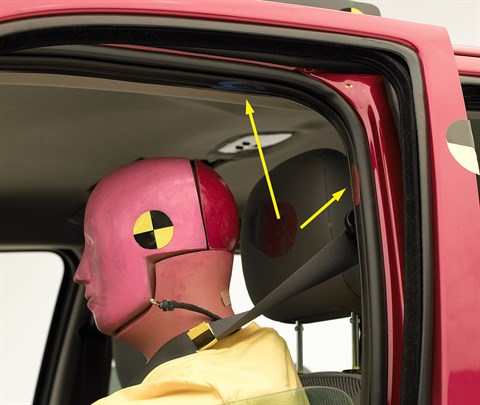
Smeared greasepaint indicates where the dummy's head hit the B-pillar and roof rail during rebound. Head accelerations from these hits were low.
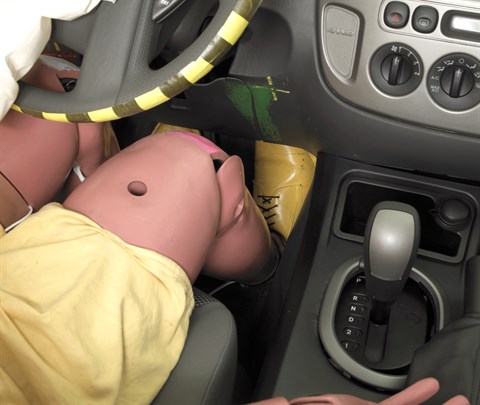
Forces on the lower right leg were high enough to indicate the likelihood of leg injury and the possibility of foot injury.
Measures of occupant compartment intrusion on driver side
| Evaluation criteria | Measurement |
|---|---|
| Test ID | CEF0413 |
| Footwell intrusion | |
| Footrest (cm) | 18 |
| Left (cm) | 27 |
| Center (cm) | 25 |
| Right (cm) | 16 |
| Brake pedal (cm) | 18 |
| Instrument panel rearward movement | |
| Left (cm) | 3 |
| Right (cm) | 2 |
| Steering column movement | |
| Upward (cm) | 6 |
| Rearward (cm) | -1 |
| A-pillar rearward movement (cm) | 3 |
Driver injury measures
| Evaluation criteria | Measurement |
|---|---|
| Test ID | CEF0413 |
| Head | |
| HIC-15 | 368 |
| Peak gs at hard contact | 22 |
| Neck | |
| Tension (kN) | 2.7 |
| Extension bending moment (Nm) | 15 |
| Maximum Nij | 0.45 |
| Chest maximum compression (mm) | 30 |
| Legs | |
| Femur force - left (kN) | 5.5 |
| Femur force - right (kN) | 6.4 |
| Knee displacement - left (mm) | 0 |
| Knee displacement - right (mm) | 4 |
| Maximum tibia index - left | 0.54 |
| Maximum tibia index - right | 1.37 |
| Tibia axial force - left (kN) | 2.7 |
| Tibia axial force - right (kN) | 5.7 |
| Foot acceleration (g) | |
| Left | 168 |
| Right | 199 |
Side: original test
Rating applies to 2008-12 models
Tested vehicle: 2005 Ford Escape XLT 4-door 4wd with optional front and rear head curtain airbags and optional front seat-mounted torso airbags
The Ford Escape and Mazda Tribute were introduced in the 2001 model year, and the Mercury Mariner was introduced in 2005. The Mazda Tribute skipped the 2007 model year, reappeared for 2008, and was discontinued after the 2011 model year. The Mercury Mariner was discontinued after the 2010 model year.
Two tests of a 2003 Escape were conducted, one with an optional side airbag for the driver, and one without. The optional side airbags were then changed from combination front seat-mounted head and torso airbags to front and rear head curtain airbags for 2005 models built through August 2004. Beginning with 2005 and later Escape, Tribute, and Mariner models manufactured after August 2004, front seat-mounted torso airbags were added to the optional front and rear head curtains (note: information about when a specific vehicle was manufactured is on the certification label typically affixed to the car on or near the driver door). A third test of an Escape, a 2005 model with all of the airbag changes, was then conducted. Injury and head protection ratings are based on only the latest test, but structural ratings are based on all three tests.
Beginning with 2008 models of the Escape, Tribute, and Mariner, the side airbags were made standard. Note: starting with 2009 models, these ratings and specifications (except weight) also apply to the hybrid (gas-electric) versions of the Escape, Mariner, and Tribute.
| Evaluation criteria | Rating |
|---|---|
| Overall evaluation | |
| Structure and safety cage | |
| Driver injury measures | |
| Head/neck | |
| Torso | |
| Pelvis/leg | |
| Driver head protection | |
| Rear passenger injury measures | |
| Head/neck | |
| Torso | |
| Pelvis/leg | |
| Rear passenger head protection | |
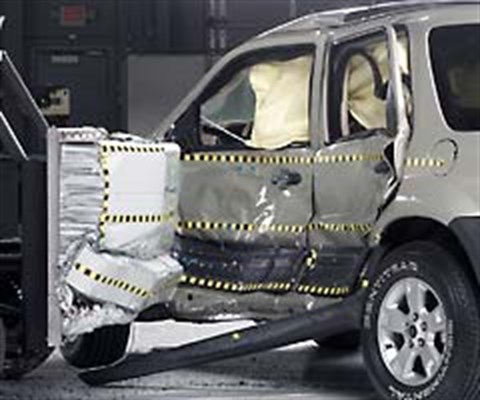
View of the vehicle and barrier just after the crash test.
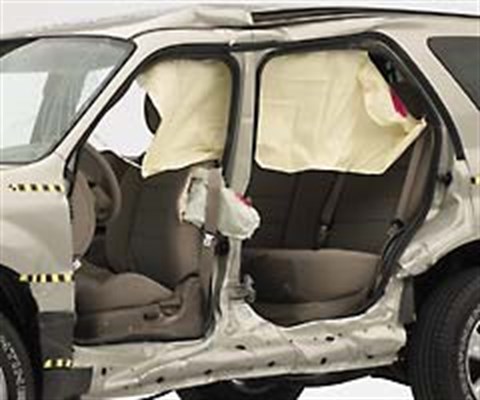
View of the vehicle after the crash with doors removed, showing the side airbags and damage to the occupant compartment.

Action shot taken during the side impact crash test showing the driver dummy's head was protected from being hit by hard structures by the side airbags.
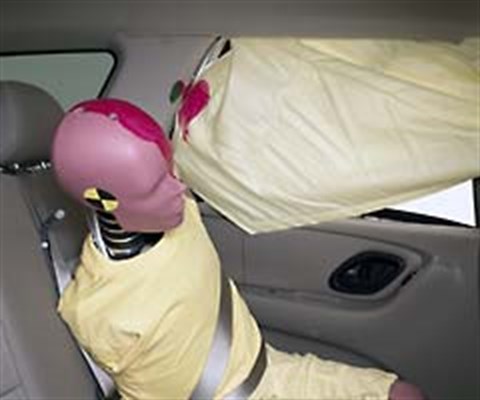
Smeared greasepaint shows where the rear passenger dummy's head was protected by the side airbag.
Measures of occupant compartment intrusion on driver side
| Test ID | CES0310 | CES0311 | CES0424 |
|---|---|---|---|
| B-pillar to longitudinal centerline of driver's seat (cm) | -6.5 | -7.5 | -5.5 |
| Negative numbers indicate the amount by which the crush stopped short of the seat centerline. | |||
Driver injury measures
| Evaluation criteria | Measurement |
|---|---|
| Test ID | CES0424 |
| Head HIC-15 | 216 |
| Neck | |
| Tension (kN) | 1.7 |
| Compression (kN) | 0.5 |
| Shoulder | |
| Lateral deflection (mm) | 47 |
| Lateral force (kN) | 2.1 |
| Torso | |
| Maximum deflection (mm) | 32 |
| Average deflection (mm) | 26 |
| Maximum deflection rate (m/s) | 3.45 |
| Maximum viscous criterion (m/s) | 0.47 |
| Pelvis | |
| Iliac force (kN) | 2.2 |
| Acetabulum force (kN) | 3.8 |
| Combined force (kN) | 5.6 |
| Left femur | |
| L-M force (kN) | 0.5 |
| L-M moment (Nm) | 52 |
| A-P moment (Nm) | 31 |
Passenger injury measures
| Evaluation criteria | Measurement |
|---|---|
| Test ID | CES0424 |
| Head HIC-15 | 306 |
| Neck | |
| Tension (kN) | 0.3 |
| Compression (kN) | 1.2 |
| Shoulder | |
| Lateral deflection (mm) | 38 |
| Lateral force (kN) | 2.0 |
| Torso | |
| Maximum deflection (mm) | 37 |
| Average deflection (mm) | 26 |
| Maximum deflection rate (m/s) | 3.54 |
| Maximum viscous criterion (m/s) | 0.49 |
| Pelvis | |
| Iliac force (kN) | 0.7 |
| Acetabulum force (kN) | 3.4 |
| Combined force (kN) | 3.8 |
| Left femur | |
| L-M force (kN) | 0.7 |
| L-M moment (Nm) | 66 |
| A-P moment (Nm) | 16 |
Roof strength
Rating applies to 2008-12 models
Tested vehicle: 2009 Ford Escape XLT 4-door 2wd
Curb weight from 2009 Ford Escape XLS 4-door 4wd. Rating does not apply to the hybrid (gas-electric) versions of these models. Rating of the hybrid versions is Poor.
| Overall evaluation | |
|---|---|
| Curb weight | 3,476 lbs |
| Peak force | 8,865 lbs |
| Strength-to-weight ratio | 2.55 |
Head restraints & seats
Seat type: All seats
| Overall evaluation | |
|---|---|
| Dynamic rating | |
| Seat/head restraint geometry |
| Seat type | All seats |
|---|---|
| Geometry | |
| Backset (mm) | 28 |
| Distance below top of head (mm) | 42 |
| Seat design parameters | |
| Pass/fail | Pass |
| Max T1 acceleration (g) | 8.4 |
| Head contact time (ms) | 106 |
| Force rating | 2 |
| Neck forces | |
| Max neck shear force (N) | 114 |
| Max neck tension (N) | 590 |
About the head restraint & seat test
Currently, IIHS tests apply only to front seats.
